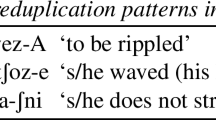Abstract
Many analyses of reduplication within Optimality Theory have relied upon the use of a prosodic template constraint to determine the surface shape of a reduplicant. Semai, a language spoken in Malaysian, presents an interesting challenge for such an analysis. The surface form of the reduplicant in the phenomenon presented here is a string of two consonants. This type of reduplication fits in with the classification of bare-consonant reduplication, where a surface reduplicant is either a single consonant or a string of two consonants. In this paper, I discuss the difficulties in applying a prosodic template analysis to this data, and I propose an alternative account. This alternative account is formulated under the Compression Model, a model in which the shape of a reduplicant is determined by the satisfaction of morphological alignment constraints, not by the use of a prosodic template.
Similar content being viewed by others
REFERENCES
Abo, Takaji, Byron W. Bender, Alfred Capelle and Tony DeBrum (1976) Marshallese-English Dictionary, The University of Hawaii Press, Honolulu.
Archangeli, Diana (1991) “Syllabification and Prosodic Templates in Yawelmani,” Natural Language and Linguistic Theory 9, 231-283.
Carlson, Katy (1997) “Sonority and Reduplication in Nakanai and Nuxalk (Bella Coola),” ms. University of Massachusetts, Amherst.
Diffloth, G. (1976) “Expressives in Semai,” in P. Jenner et al. (eds.), Austroasiatic Studies, The University Press of Hawaii, Honolulu.
Gafos, Adamantios (1999) “On the Proper Characterization of Nonconcatenative Languages,” ms., The Johns Hopkins University.
Hammond, Michael (2001) “There is No Lexicon!,” Coyote Papers 10: Working Papers in Linguistics, University of Arizona Linguistics Circle, Tucson.
Hendricks, Sean (1997) “Koasati Punctual Reduplication: Morphemic Fixed Segments and Phonological Bases,” ms., University of Arizona.
Hendricks, Sean (1999a) “Hopi Nominal Reduplication without Templates,” WECOL 98: Proceedings of the 1998 Conference of the West Coast Conference on Linguistics, Tempe.
Hendricks, Sean (1999b) Reduplication without Template Constraints: A Case Study in Bare-Consonant Reduplication, PhD Dissertation, University of Arizona.
Hendricks, Sean (2001) “Bare-Consonant Reduplication in Marshallese Consonant Doubling,” presented at the Annual Meeting of te Linguistics Society of America, Washington, DC.
McCarthy, John J. and Alan Prince (1986) “Prosodic Morphology,” ms., University of Massachusetts, Amherst and Brandeis University.
McCarthy, John J. and Alan Prince (1993a) Prosodic Morphology I: Constraint Interaction and Satisfaction, Technical Report #3, Rutgers University Center for Cognitive Science.
McCarthy, John J. and Alan Prince (1993b) “Generalized Alignment,” in G. Booij and J. van Marle (eds.), Yearbook of Morphology, Kluwer Academic Publishers, Dordrecht, pp. 79-153.
McCarthy, John J. and Prince (1995) “,” in J. Beckman, L. Walsh Dickey and S. Urbanczyk (eds.), University of Massachusetts Occasional Papers in Linguistics 18, University of Massachusetts, pp. 249-384.
McCarthy, John J. and Alan Prince (1998) “Faithfulness and Prosodic Morphology,” in R. Kager, H. van der Hulst and W. Zonneveld (eds.), The Prosody Morphology Interface, Cambridge University Press, Cambridge, Massachusetts, pp. 218-309.
Newman, Stanley (1944) Yokuts Language of California, Viking Fund Publications in Anthropology 2, The Viking Fund, New York.
Parkin, Robert (1991) A Guide to Austroasiatic Speakers and Their Languages, University of Hawaii Press, Honolulu.
Prince, Alan and Paul Smolensky (1992) Optimality Theory: Constraint Interaction in Generative Grammar, paper presented at 12th West Coast Conference on Formal Linguistics, Los Angeles.
Russell, Kevin (1995) “Morphemes and Candidates in Optimality Theory,” ms., University of Manitoba.
Selkirk, Elizabeth (1980a) “Prosodic Domains in Phonology: Sanskrit Revisited,” in M. Aronoff and M.-L. Kean (eds.), Juncture, Anma Libri, Saratoga, CA, pp. 107-129.
Selkirk, Elizabeth (1980b) “The Role of Prosodic Categories in English Word Stress,” Linguistic Inquiry 11, 563-605.
Shaw, Patricia (1993) “The Prosodic Constituency of Minor Syllables,” in E. Duncan, D. Farkas and P. Spade (eds), The Proceedings of the Twelfth West Coast Conference on Formal Linguistics, pp. 117-132.
Skim, Minsu (1996) “Edge Reduplication and Anchoring in Correspondence Theory,” ms., Indiana University.
Sloan, Kelly (1988) “Bare-Consonant Reduplication: Implications for a Prosodic Theory of Reduplication,” in H. Borer (ed.), Proceedings of the Seventh West Coast Conference on Formal Linguistics, Stanford Linguistic Association, Stanford, CA, pp. 319-330.
Spaelti, Philip (1997) Dimensions of Variation in Multi-pattern Reduplication, PhD Dissertation, University of California, Santa Cruz.
Urbanczyk, Suzanne (1996) “Morphological Templates in Reduplication,” in Proceedings of the North-East Linguistic Society 26, Graduate Linguistics Student Association, Amherst, pp. 425-440.
Walker, Rachel (2000) “Nasal Reduplication in Mbe Affixation,” Phonology 17, 65-115.
Author information
Authors and Affiliations
Rights and permissions
About this article
Cite this article
Hendricks, S. Bare-Consonant Reduplication Without Prosodic Templates: Expressive Reduplication in Semai. Journal of East Asian Linguistics 10, 287–306 (2001). https://doi.org/10.1023/A:1017923215691
Issue Date:
DOI: https://doi.org/10.1023/A:1017923215691




